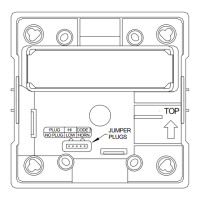P84030 D
Sheet 8 of 10
MOUNTING PROCEDURES:
CAUTION: Check that the installed product will have sufficient clearance and wiring room prior to installing backboxes and
conduit, especially if sheathed multiconductor cable or 3/4" conduit fittings are used.
1. NS models have an integrated NS Mounting Plate (NSMP).
2. The NS Mounting Plate (NSMP) must be oriented correctly when it is mounted to the backbox. Turn the NSMP so that the
arrow below the word “Top” points to the top side of the NSMP.
3. NS models can be flush mounted to a standard single-gang backbox (Figure A), 4” or 100mm backbox (Figure B) or double-
gang backbox (Figure C). NS models can also be surface mounted to a 4” or 100mm backbox (Figure B), double-gang backbox
(Figure C) or the SHBB (Figure D).
4. Mount the NSMP first to the backbox. Next slide the Beauty Plate over the NSMP until the 2 side snaps of the NS Beauty Plate
engage with the NSMP.
5. The NS Beauty Plate can be removed from the strobe assembly once engaged. First, gently insert a screwdriver into one of the
slots located on the side edges of the NS Beauty Plate. Second, gently pull away from the wall with the inserted screwdriver to
disengage the snap. Third, repeat the first and second steps for the second slot. Finally, gently lift the Beauty Plate away from
the NSMP.
6. Mounting hardware for each mounting option is supplied.
7. Conduit entrances to the backbox should be selected to provide sufficient wiring clearance for the installed product.
8. When terminating field wires, do not use more lead length than required. Excess lead length could result in insufficient wiring
space for the signaling appliance.
9. Use care and proper techniques to position the field wires in the backbox so that they use minimum space and produce minimum
stress on the product. This is especially important for stiff, heavy gauge wires and wires with thick insulation or sheathing.
10. Do not pass additional wires (used for other than the signaling appliance) through the backbox. Such additional wires could
result in insufficient wiring space for the signaling appliance.
CAUTION: If these appliances are operated within 15 inches of a person's ear, they can produce a sound pressure level that
exceeds the maximum 120dBA permitted by ADA and OSHA rules. Exposure to such sound levels can result in damage to a person's
hearing.

